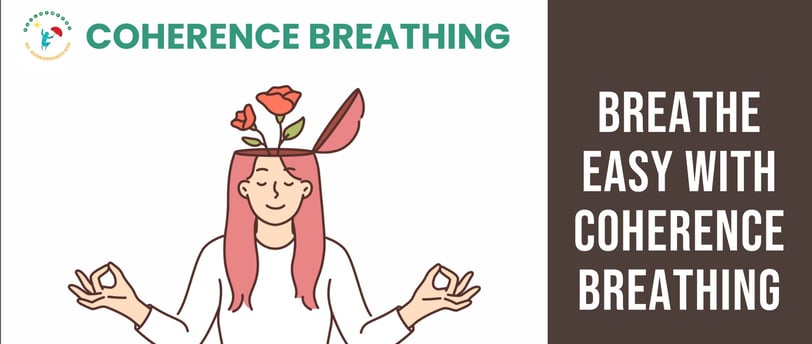Coherence Breathing: The Simple Secret to Stress-Free Living
In the hustle of everyday life, we often underestimate the power of something as simple as our breath. But did you know that a specific breathing technique—coherence breathing—can significantly impact mental health, emotional resilience, and cognitive clarity? Rooted in ancient practices and backed by modern science, coherence breathing, championed by Dr. Stephen Elliott, helps regulate the nervous system, reduce stress, and improve focus. It's a game-changer for professionals, students, and anyone navigating high-pressure environments. I've written an article exploring the origins, benefits, and practical applications of coherence breathing. If you're looking for an accessible way to enhance your well-being, I highly recommend giving it a read! Have you ever tried breathwork techniques like coherence breathing?


Coherence Breathing: A Simple Yet Powerful Tool for Mental Well-Being
In today’s fast-paced world, stress, anxiety, and emotional turbulence have become increasingly common. While therapy, medication, and lifestyle modifications play crucial roles in mental health management, a simple, often overlooked tool—breath—can be just as transformative. One such scientifically backed breathing technique is coherence breathing, a rhythmic and controlled way of breathing that promotes balance in the nervous system and fosters emotional resilience.
The Origins of Coherence Breathing
Coherence breathing was popularized by Dr. Stephen Elliott, a researcher and author who has extensively studied the impact of breathwork on physiological coherence. His work has contributed to the scientific validation of this technique, demonstrating its ability to enhance autonomic balance and mental well-being. Coherence breathing has its roots in ancient yogic and meditative practices, which have long emphasized the importance of breath control in achieving mental and physical balance. Modern scientific studies have validated these ancient insights, showing that slow, rhythmic breathing can significantly influence the autonomic nervous system, reducing stress and enhancing overall well-being. Researchers in the fields of psychophysiology and neurobiology have explored coherence breathing’s ability to synchronize heart rate variability, brain waves, and hormonal balance, reinforcing its practical benefits in mental health management.
What is Coherence Breathing?
Coherence breathing, also known as resonant breathing, is a technique where you inhale and exhale at a slow, steady pace, typically around 5 to 6 breaths per minute. This pattern synchronizes the heart rate, respiration, and nervous system, creating a state of physiological coherence. Unlike rapid or erratic breathing, coherence breathing stabilizes internal bodily rhythms, leading to enhanced emotional and cognitive functions.
How Does Coherence Breathing Impact Mental Health?
Coherence breathing influences mental health through its effects on the autonomic nervous system (ANS), particularly by enhancing parasympathetic activity (the “rest and digest” mode) while reducing sympathetic overactivity (the “fight or flight” response). Here’s how it helps:
Reduces Stress and Anxiety: Coherence breathing activates the vagus nerve, which plays a crucial role in relaxation and emotional regulation. By slowing the breath, it signals the brain that the body is safe, lowering cortisol levels and easing symptoms of anxiety.
Enhances Emotional Regulation: Studies suggest that breathing at a coherent rhythm can help regulate emotions by stabilizing the heart’s rhythm, preventing erratic emotional reactions, and fostering a calm, balanced state of mind.
Improves Focus and Cognitive Clarity: With reduced stress comes improved mental clarity. Regular practice of coherence breathing can enhance attention, decision-making, and cognitive flexibility, making it an excellent tool for professionals and students alike.
Promotes Better Sleep: Sleep disturbances are often linked to an overactive nervous system. Coherence breathing, especially before bedtime, induces relaxation and helps the body transition into a restful state, improving sleep quality.
Boosts Resilience and Well-Being: Practicing coherence breathing regularly builds emotional resilience, helping individuals better cope with life’s challenges. It fosters a sense of inner stability and promotes overall well-being.
Practical Impacts of Coherence Breathing
Beyond mental health benefits, coherence breathing has tangible effects on physical health. Regular practice has been linked to lower blood pressure, improved heart rate variability, and enhanced immune function. Many athletes, business professionals, and individuals facing high-stress environments integrate coherence breathing into their daily routines to maintain peak performance and prevent burnout. Moreover, healthcare professionals have increasingly recommended this practice as a complementary approach for managing conditions like hypertension, PTSD, and depression.
How to Practice Coherence Breathing
Coherence breathing is simple and can be practiced anywhere. Follow these steps:
Find a Comfortable Position: Sit or lie down in a relaxed posture.
Inhale Slowly Through the Nose for 5-6 Seconds.
Exhale Gently Through the Mouth for 5-6 Seconds.
Continue for 5-10 Minutes: Breathe in a rhythmic pattern, focusing on smooth, even breaths.
Practice Regularly: Aim to incorporate this technique into your daily routine, especially during stressful moments or before sleep.
Final Thoughts
Coherence breathing is a powerful yet simple tool that can significantly improve mental health. By harmonizing the body’s internal rhythms, it cultivates a sense of calm, clarity, and emotional balance. Whether used as a standalone practice or in conjunction with therapy and other wellness strategies, coherence breathing serves as a valuable self-care technique in navigating modern-day stressors. Give it a try—your mind and body will thank you!
